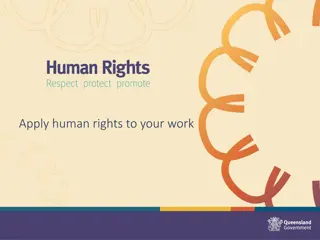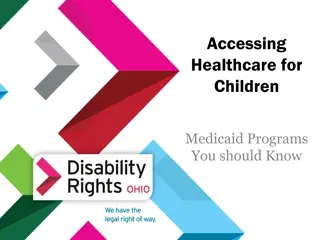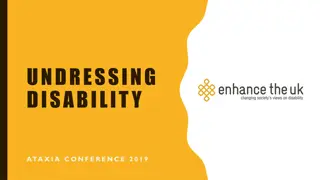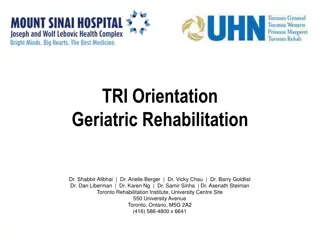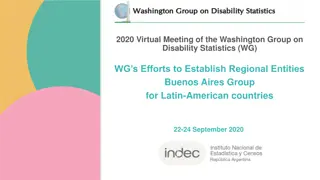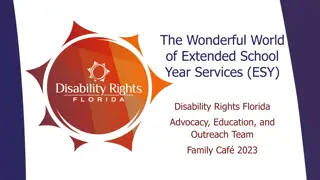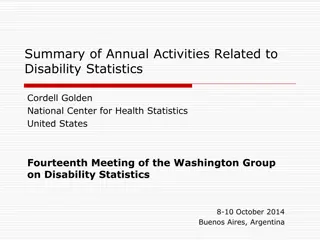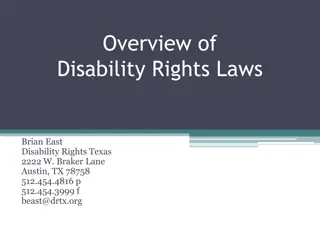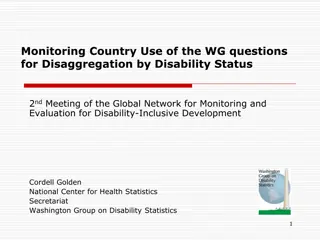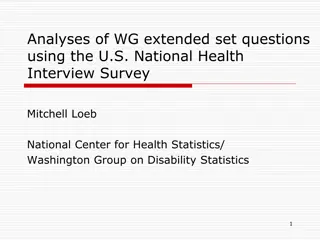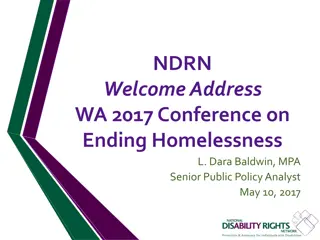Understanding Disability Rights in Healthcare Regulations
The content discusses the prevalence of disabilities in the United States, laws such as the ADA and Section 504 that protect the rights of individuals with disabilities in healthcare settings, and coverage of different healthcare entities under Titles II and III. It emphasizes equal opportunities for persons with disabilities and outlines regulations for state and local governmental healthcare facilities.
Download Presentation

Please find below an Image/Link to download the presentation.
The content on the website is provided AS IS for your information and personal use only. It may not be sold, licensed, or shared on other websites without obtaining consent from the author. Download presentation by click this link. If you encounter any issues during the download, it is possible that the publisher has removed the file from their server.
E N D
Presentation Transcript
Steven E. Gordon Assistant United States Attorney Civil Rights Enforcement Coordinator USAO Eastern District of Virginia Lisa Bothwell Program Analyst U.S. Department of Health and Human Services Administration for Community Living John Thompson Civil Rights Analyst U.S. Department of Health and Human Services Office for Civil Rights 2
Opinions expressed herein or otherwise are those of the speakers and do not necessarily reflect the views of the United States Department of Justice or the United States Department of Health and Human Services. 3
The CDC estimates that approximately 64 million adults aged 18 or older in the United States had some kind of disability in 2020. CDC Disability and Health Data System. Based on a hearing loss prevalence study, the National Institute on Deafness and Other Communication Disorders (NIDCD) reports that one in eight people in the United States (13 percent, or 30 million) aged 12 or older has hearing loss in both ears, based on standard hearing examinations. 4
The ADA prohibits discrimination and ensures equal opportunities for persons with disabilities in: Employment (Title I) State and local government services (Title II) Public accommodations (Title III) Telecommunication Services (Title IV) 5
All state and local governmental entities are covered by Title II, including the following entities operated by state and local governments that have a healthcare mission: Hospitals operated by state or local governments, including state universities and psychiatric hospitals. State and local mental health agencies. State universities that have infirmaries. Jails and correctional facilities, including their infirmaries. 6
Title III covers public accommodations, which include a wide range of entities, such as: (1) Hospitals; (2) Nursing homes; and (3) Professional office of a health care provider. 42 U.S.C. 12181(7)(K); ADA Technical Assistance Manual, III-1.2000.C. (1994 Supplement) ( nursing homes are expressly covered in Title III regulations as social service establishments ). 7
Section 504 of the Rehabilitation Act applies to recipients of Federal financial assistance (FFA). This includes most: Hospitals; Nursing Homes; and Physician s Offices. Section 1557 of the Affordable Care Act (ACA) applies to covered health programs and activities provided by covered entities, including: Health programs and activities that receive FFA; Programs or activities administered by HHS under Title I of the ACA; and Programs or activities administered by an entity established under Title I of the ACA. Sections 504 and 1557 provide similar protections for individuals with disabilities to those provided under the ADA. 8
A skilled nursing facility (SNF) operated by a private entity provides a variety of services to its residents, including healthcare, medication administration, assistance with activities of daily life, and providing meals. Is it covered by the ADA? Section 504? Section 1557? 9
Both privately operated and state operated SNFs are covered by the ADA. SNFs that receive financial assistance from the Federal government are covered under Sections 504 and 1557. 10
A physical or mental impairment that substantially limits one or more major life activities (e.g., hearing, seeing, walking or operation of bodily function such as immune system). A record of such an impairment. Being regarded as having such an impairment. 42 U.S.C. 12102 11
Caring for oneself, performing manual tasks, seeing, hearing, eating, sleeping, walking, standing, lifting, bending, speaking, breathing, learning, reading, concentrating, thinking, communicating, and working. A major life activity also includes the operation of a major bodily function, including but not limited to, functions of the immune system, normal cell growth, digestive, bowel, bladder, neurological, brain, respiratory, circulatory, endocrine, and reproductive functions. 12
The general principle underlying the ADA is that [n]o individual shall be discriminated against on the basis of disability in the full and equal enjoyment of the goods, services, facilities, privileges, advantages, or accommodations of any place of public accommodation by any person who owns, leases (or leases to), or operates a place of public accommodation. 42 U.S.C. 12182(a). 13
The ADA . . . Specifically prohibits discrimination against [individuals with disabilities], not just based on invidious affirmative animus, but also based on thoughtlessness, apathy, and stereotypes about disabled persons. 14
Failing to provide auxiliary aids or services to individuals who have communication disabilities. 42 U.S.C. 12182(b)(2)(A)(iii); 28 C.F.R. 35.160 & 36.303; 45 C.F.R. 84.52(d); 45 C.F.R. 92.102. Imposing a surcharge on an individual with a disability to cover the cost of compliance with the ADA. 28 C.F.R. 35.130(f); 28 C.F.R. 36.301(c). Failing to make reasonable modifications to policies, practices, or procedures when the modifications are necessary to avoid discrimination on the basis of disability, unless the public entity can demonstrate that making the modifications would fundamentally alter the nature of the service, program, or activity. 42 U.S.C. 12182(b)(2)(A)(ii); 45 C.F.R. 92.105. 15
A skilled nursing facility does not accept individuals who are deaf and communicate using sign language because it does not offer sign language services. Is this a potential violation of Federal disability rights laws? 16
Brookside Rehab & Health Center Refused admission to an individual who need sign language interpreting services. Equitable relief, $40,000 in compensatory damages, and $50,000 in civil penalty. https://www.ada.gov/brookside_rehab_sa.h tml 17
Entities must take appropriate steps to ensure that communication with people with disabilities is as effective as communication with others, including through the provision of appropriate auxiliary aids and services. 28 C.F.R. 35.160(a)(1); 45 C.F.R. 92.102(a). The type of auxiliary aid needed to provide effective communication will vary by context and depends on many factors. vary by context and depends on many factors. 18
A new patient who has a communication disability comes for services. How do you determine what auxiliary aid or service is necessary? 19
The type of auxiliary aid needed to provide effective communication will vary by consumer and depends on many factors. vary by consumer and depends on many factors. 20
(1) What is the method of communication used by the individual? (e.g., ASL, signed English, oral interpreter) (2) How lengthy is the communication? (3) How complex is the communication? (4) What is the nature of the communication? (5) What is the context of the communication? What is the method of communication used by the individual? (e.g., ASL, signed English, oral interpreter) 21
The ADA regulations explain that public accommodations should consult with individuals with disabilities whenever possible to determine the type of auxiliary aid is needed to ensure effective communication. 28 C.F.R. 36.303(c)(1)(ii). 22
ASL is not derived from English; ASL has its own syntax and grammar and utilizes signs made by hand motions, facial expressions, eye gazes, and body postures. Therefore, the vast majority of deaf people communicate effectively in English, whether by writing notes or reading lips Columbia, 128 F.Supp.3d 250, 275 (D.D.C. 2015) (cites to record omitted) (emphasis added). the vast majority of deaf lack the ability to people [plaintiff] included communicate effectively in English, whether by writing notes or reading lips. Pierce v. District of [plaintiff] included lack the ability to 23
There are many types of auxiliary aids and services, including, but not limited to: Real-time captioning (a.k.a., CART); CapTel Phone; Cued-speech interpreter; Assistive listening systems and devices; Hearing-aid compatible telephones; Videophones; and Sign language interpreting (ASL, signed English, etc.). 28 C.F.R. 35.104; 28 C.F.R. 36.303(b). 25
Computer Assisted Real-Time Transcription (CART) Many people who are deaf or hard of hearing are not trained in either sign language or speech reading. CART is a service in which an operator types what is said into a computer that displays the typed words on a screen. DOJ ADA Business Brief: Communicating with People who are Deaf or Hard of Hearing in Hospital Settings 26
Personal amplifiers Hearing aid compatible telephones TTY Other technology, including captioned telephones (such as Captel phones) 27
Information provided by video should be captioned Televisions for patients in hospitals TTY, if telephone is offered to others Telehealth and web content video platforms 28
A doctor uses sign language interpreter to communicate with a patient who is deaf. 31
DOJs section-by-section analysis of the ADA regulations provides guidance on the limited types of communication for which the exchange of notes will constitute effective communication and discusses DOJ s policy: Exchange of notes substantial conversation tests or regular allergy shots are administered. However, interpreters should be used when the matter involves more complexity, such as in communication of medical history or diagnosis, in conversations about medical procedures and treatment decisions, or in communication of instructions for care at home or elsewhere in which use of interpreters or captioning is necessary. Additional guidance on this issue can be found in a number of agreements entered into with health care providers and hospitals that are available on the Department s Web site at http://www.ada.gov. Exchange of notes likely will be effective in situations that do not involve substantial conversation, for example, when blood is drawn for routine lab do not involve However, interpreters should be used when the matter involves more complexity, such as in communication of medical history or diagnosis, in conversations about medical procedures and treatment decisions, or in communication of instructions for care at home or elsewhere. The Department discussed in the NPRM the kinds of situations 28 C.F.R. Pt. 36, App. A, 36.303 (emphasis added). 32
ILLUSTRATION 2a: H goes to his doctor for a bi-weekly checkup, during which the nurse records H s blood pressure and weight. Exchanging notes and using gestures are likely to provide an effective means of communication at this type of check-up. BUT: Upon experiencing symptoms of a mild stroke, H returns to his doctor for a thorough examination and battery of tests and requests that an interpreter be provided. H s doctor should arrange for the services of a qualified interpreter, as an interpreter is likely to be necessary for effective communication with H, given the length and complexity of the communication involved. Dep t of Justice, Technical Assistance Manual, III-4.3200 (1994 Supplement). 33
If an interpreter is required, a covered entity must furnish a qualified interpreter. 28 C.F.R. 35.104 & 36.104. 35
Able to interpret: Effectively what the person with the disability is saying) and expressively (i.e., having the skill needed to convey information back to that person) using the sign language of the individual needing the interpreter Accurately Impartially Understanding the necessary specialized vocabulary used for the particular setting (e.g., not all interpreters are qualified for medical settings). 28 C.F.R. 36.104 (definition of qualified interpreter ); see also Technical Assistance Manual, III-4.3200. Effectively interprets both receptively (i.e., understanding using the sign language of the individual needing the interpreter (e.g., ASL, Signed English, etc.) Accurately Impartially specialized vocabulary that is 36
You have an employee who took two semesters of American Sign Language in high school. Is she qualified to interpret for a care planning meeting to discuss services that SNF will be providing to a resident, who is deaf and uses ASL as her primary means of communication? 37
Can a public accommodation use a staff member who signs pretty well as an interpreter for meetings with individuals who use sign language to communicate? Signing and interpreting are not the same thing. does not mean that a person can process spoken communication into the proper signs, nor does it mean that he or she possesses the proper skills to observe someone signing and change their signed or fingerspelled communication into spoken words. The interpreter must be able to interpret both receptively and expressively Americans with Disabilities Act, Technical Assistance Manual, III-4.3100. Signing and interpreting are not the same thing. Being able to sign The interpreter must be able to interpret both receptively and expressively. 38
If a sign language interpreter is required for effective communication, must only a certified interpreter be provided? No. The key question in determining whether effective communication will result is whether the interpreter is qualified by an official licensing body. A qualified interpreter is one who is able to interpret effectively receptively An individual does not have to be certified in order to meet this standard. A certified interpreter may not meet this standard in all situations, e.g. , where the interpreter is not familiar with the specialized vocabulary involved in the communication at issue. Americans with Disabilities Act, Technical Assistance Manual, III-4.3100 (emphasis added). qualified, not whether he or she has been certified effectively, accurately receptively and expressively accurately and impartially expressively, using necessary specialized vocabulary impartially, both specialized vocabulary. 39
In Fairfax Nursing Center and Arlington Sherriff, these entities enlisted personnel, who did not have the requisite skills to be a qualified interpreter, to facilitate communication for important meetings without first having the employees evaluated to determine whether they had the requisite ASL skills to perform as an interpreter. My office arranged to have these employees ASL skills evaluated, which revealed that they did not have the requisite skills to be qualified interpreters. https://www.ada.gov/fairfax_nursing_ctr_sa.html https://www.ada.gov/arlington_co_sheriff_sa.html 40
Many commenters questioned the proposed deletion of the requirement that a qualified interpreter be able to interpret both receptively and expressively, noting the importance of both these skills. Commenters noted that this phrase was carefully crafted in the original regulation to make certain that interpreters both (1) are capable of understanding what a person with a disability is saying and (2) have the skills needed to convey information back to that individual. These are two very different skill sets and both are equally important to achieve effective communication. have the skills needed to convey information back to that individual. These are two very different skill sets and both are equally important to achieve effective communication. Section by Section Analysis of ADA Regulations 41
If an individual who needs a sign language interpreter also has another disability, such as paralysis due to a stroke, what type of interpreter services should you look for? 42
In order for an interpreter to be a qualified interpreter, s/he must be able to interpret effectively for the individual needing the interpreting services. 28 C.F.R. 35.104 & 36.104. 43
Certified Deaf Interpreters are deaf or hard of hearing interpreters who work with hearing sign language interpreters communication needs of deaf individuals. who work with hearing sign language interpreters to meet the specific Section-by-Section Analysis of the ADA regulations A CDI can facilitate communication with patients who have limited language skills or severe language deficits, neurologic and/or cognitive deficits, or a major mental illness. More than signing: Communicating with the Deaf, Nursing Management (March 2014), at 20-27. CDIs are particularly important for consumers with language dysfluency. 44
You have a consumer who is both deaf and blind. What kind of auxiliary aid or service might work for that consumer? 45
There are specialized interpreters for individuals who are both deaf and blind that use tactile or pro- tactile interpreting. 46
A skilled nursing facility sets up a care planning meeting for a resident. The resident wants his son, who is deaf, to participate in the care planning meeting. Is the SNF required to provide a sign language interpreter for his son? 47
The ADA regulations require public accommodations to furnish auxiliary aids and services to individuals with disabilities and companions who are individuals with disabilities. 28 C.F.R. 36.303(c). 48
[C]ompanion means a family member, friend, or associate of an individual seeking access to, or participating in, the goods, services, facilities, privileges, advantages, or accommodations of a public accommodation, who, along with such individual, is an appropriate person with whom the public accommodation should communicate. 28 C.F.R. 36.303(c)(1)(ii). 49
Spotsylvania Regional Medical Center Failure to provide ASL services to the daughter, who is deaf, of a patient during critical interactions, including a late night emergency admission and discussions regarding end of life issues. Equitable relief and $121,000 in compensatory damages. 50



